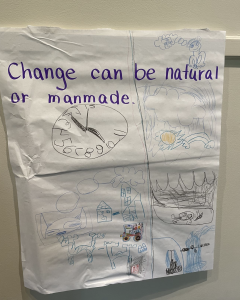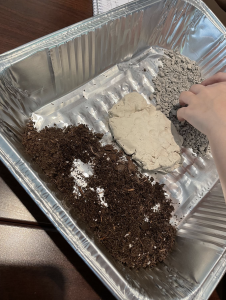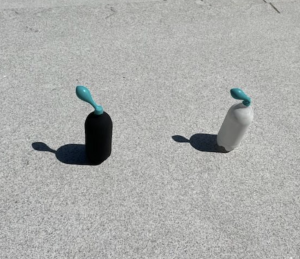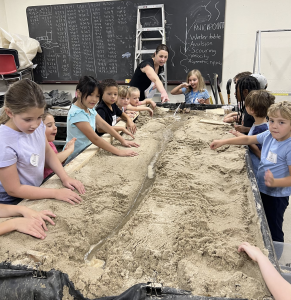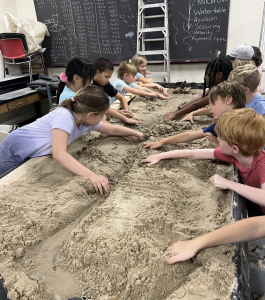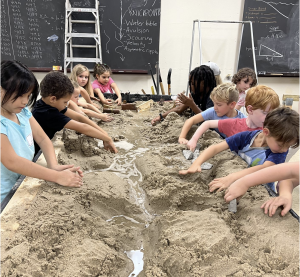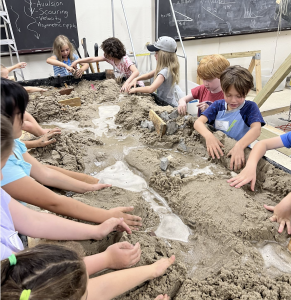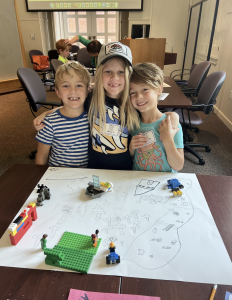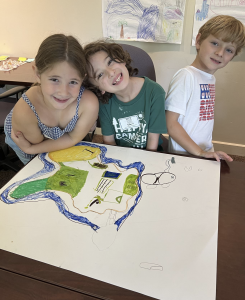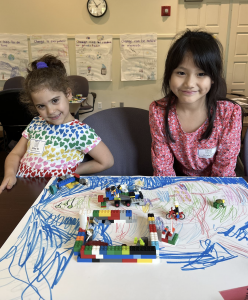Summer SAVY 2022/Session 5 – Environmental Explorations for Rising 1st/2nd Grade
Posted by caughem on Monday, July 18, 2022 in blog, SAVY.
Friday: Our final day in Environmental Explorations was busy and full of excitement! Thank you for allowing us to spend the week with your children. I hope they are able to use the knowledge they gained this week in school, and beyond, as they consider their impact on the environment. Today we focused on presentations and then celebrated with a BreakoutEDU game about erosion and weathering. I’m impressed with the problem-solving skills I observed during that challenge!
Over the course of the week, each team planned for today’s final project. Today, they combined those ideas to create a final model of their plan to save Queen Anne’s Island. These are questions used in class during presentations. Your child may want to present their plan to you using the photographs in the blog post.
- How will you reduce air pollution on the island?
- Which source of renewable energy will you use on the island to reduce dependency on coal from the mainland?
- How will you clean up waste in the ocean?
- What happens to the waste after it is removed from the ocean?
- How will you prevent future erosion along the coastline?
- What is your plan to protect trees on the island? What will you do to help the forest after the furniture factory cuts down trees?
- What did your group plan for Preservation Park?
- How will you reduce the amount of waste at the landfill on the island?
- What can you do to reduce waste and pollution to protect your environment?
Enjoy the rest of the summer and best wishes for an amazing school year!
Thursday: What a busy day of learning! This morning our guest, Miss Jessica, took us to the stream table lab in the Stevenson Center. This is where she teaches college students about erosion. Students worked to create two different stream models using sand. When Miss Jessica turned on the water source, we observed eroding sediment and identified the parts of the land most at risk. Then, they worked together to use rocks and wood to create and test different barriers, dams, and “seawalls.” As the water flowed down the table, we observed which models were effective in preventing erosion. The students used this experience later in the day to make a plan to prevent future erosion at Queen Anne’s Island. (Thank you for making sure your child had everything they needed for the field trip!)
After lunch our guest speaker, Miss Amanda, taught us about recycling. She explained the process of sorting materials and told students about what she learned when she toured the real recycling complex for the city of Nashville. Students learned which materials can be recycled. They also brainstormed ways to reuse, reduce, and refuse waste to reduce their environmental impact. Since plastic bags get caught in the sorting equipment, they cannot be placed in on-campus plastic recycling bins. Students used plastic bags to create flowers to learn that something beautiful can be made from what most consider to be trash. Students used this information to create a plan to reduce trash pollution in the ocean around Queen Anne’s Island.
Students entered the final planning stages for the problem-solving challenge today. They synthesized ideas as a group and asked final questions. Tomorrow each team will create a model of their plan for the island and present their plans to their peers. Students will act as the committee and ask questions to the group presenting. I will share this experience with you through tomorrow’s blog post. We’ve learned about the problem-solving process with the help of the Global Problem Solvers this week. If your child wants to watch Season One or learn more about this super team, visit
https://gpstheseries.com/en-us/Wednesday: We had a busy day today! Students learned about renewable and non-renewable sources of electricity. Each team researched three renewable energy options that could replace the coal power plant on Queen Anne’s Island. They selected the option they feel is best to reduce pollution and provide needed electricity to the island. Each group created a commercial for the energy source selected and performed them for the class. They will use the information they learned in their final presentations on Friday.
Today students participated in two experiments. The first involved painted plastic two-liter bottles and balloons! Students predicted if light or dark colors absorbed more energy from the sun. We placed the bottles outside and watched the balloons inflate. Your child can tell you if their hyptothesis was correct! The other experiment involved an oil spill (vegetable oil) simulation. Students tested methods to clean feathers covered in oil. They determined that dish soap was most effective, baking soda dried the feathers (but left some oil residue), and paper towels were ineffective. We discussed the oil platform off the coast of the island and the risk it poses to animals in the ocean.
Please remember long pants and close-toed shoes tomorrow. Our field trip will be in the morning and we have a special guest joining us in the afternoon to speak about recycling on campus at Vanderbilt. We have a busy day of learning planned for you tomorrow!
Tuesday: This morning students learned about renewable and non-renewable resources. They listed natural resources found in Tennessee and sorted them into two categories: renewable and non-renewable resources. I introduced the change big ideas: change has to do with time, change is everywhere, change may be random or predictable, and change can be natural or manmade. Students worked with their table group to illustrate a poster for one of the big ideas about change. They are displayed in the classroom as a learning resource for the week.
Today’s experiment allowed students to “dig deeper” to understand the layers of soil. This information will be used later this week during our study of erosion. Students were introduced to their problem-solving team today. We predicted future problems if pollution continues to affect the air quality and water quality at Queen Anne’s Island. Students brainstormed solutions to ensure pollution doesn’t harm the natural resources on the island.
As a reminder, students need to wear long pants and close-toed shoes on Thursday for our field trip. Have a wonderful evening!
Monday: Welcome to Environmental Explorations! Today’s instruction focused on foundational skills for future learning. Students learned about natural resources and identified natural resources found in their environment. They also learned how scientists conduct experiments using the “wheel of scientific investigation and reasoning.” For our first experiment, I posed the question “Can people simulate wind?” Students set up an experiment involving feathers and collected data. As a control group, we observed how the wind moved feathers outside our building.
To build a foundation for the “big idea” of change, we made a concept map for the word change. To continue this conversation at home, you can ask your students to identify changes they observed during the day. We watched the Global Problem Solvers model the first part of the problem-solving process: identifying the problem. Then, we worked together to list problems on Queen Anne’s Island. Students had time to learn independently or in small groups at learning stations at the end of the day.
On Thursday, we will take a field trip to a lab on campus at Vanderbilt. Students will participate in an erosion simulation! All students must wear long pants and close-toed shoes to meet the dress code for the lab. I will send a note home on Wednesday with a reminder. The field trip will take place in the morning to avoid walking across campus in the hottest part of the day.
